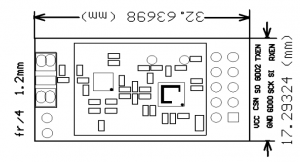CC2500
CC2500L Board
Module works at 3.3V, if not concern the Low Energy mode, you can connect directly to 5V, but it is better to add some 1K resistor to drop to voltage, or use LDO regulator
Pin Definition, Size
| Pin | Header text | Header text |
|---|---|---|
| 1 | GND | GND (rectangle pad) |
| 2 | VCC | VCC |
| 3 | GDO0 | other function pin |
| 4 | CSN | SPI Enable |
| 5 | SCK | SPI Clock |
| 6 | SO | Data Out |
| 7 | SI | Data In |
| 8 | GDO2 | other function pin |
| 9 | RXEN | Connect to VCC, |
| 10 | TXEN | in RX mode, TXEN = 1, in TX mode, RXEN = 0 |
Electrical Characteristics
| Name | specification |
|---|---|
| operational current | 14mA @ RX mode, 120mA @ TX mode |
| operational frequency | 2400 – 2483 MHz ISM Band |
| Transmission power | 16dbM |
| Sensitivity | ‐110dBm (typical) @ 10Kbps mode |
| modulation | FSK /GFSK/MSK |
| Tested Distance | 1.5 KM |
| Module Size | 33mm(L) x 17mm(W) x 5mm(H) |
CC2500 Arduino Demo Code
More Power expecification can refer to Data CC2500 documents
INT8U PaTabel[8] = {0xC0 ,0xC0 ,0xC0 ,0xC0 ,0xC0 ,0xC0 ,0xC0 ,0xC0};
SPI RW operation
INT8U SpiTxRxByte(INT8U dat)
{
INT8U i,temp;
temp = 0;
SCK = 0;
for(i=0; i<8; i++)
{
if(dat & 0x80)
{
MOSI = 1;
}
else MOSI = 0;
dat <<= 1;
SCK = 1;
_nop_();
_nop_();
temp <<= 1;
if(MISO)temp++;
SCK = 0;
_nop_();
_nop_();
}
return temp;
}
SPI Write Register
void halSpiWriteReg(INT8U addr, INT8U value)
{
CSN = 0;
while (MISO);
SpiTxRxByte(addr); // Write address
SpiTxRxByte(value); // write data
CSN = 1;
}
SPI Read register operation
INT8U halSpiReadReg(INT8U addr)
{
INT8U temp, value;
temp = addr|READ_SINGLE;//read register command
CSN = 0;
while (MISO);
SpiTxRxByte(temp);
value = SpiTxRxByte(0);
CSN = 1;
return value;
}
CC2500 software reset
void RESET_CC2500(void)
{
CSN = 0;
while (MISO);
SpiTxRxByte(CCxxx0_SRES); //write register command
while (MISO);
CSN = 1;
}
CC2500 Initialization
const RF_SETTINGS rfSettings =
{
0x00,
0x07, // FSCTRL1 Frequency synthesizer control.
0x00, // FSCTRL0 Frequency synthesizer control.
0x5C, // FREQ2 Frequency control word, high byte.
0x58, // FREQ1 Frequency control word, middle byte.
0x9D, // FREQ0 Frequency control word, low byte.
0x0E, // MDMCFG4 Modem configuration.
0x3B, // MDMCFG3 Modem configuration.
0x73, // MDMCFG2 Modem configuration.
0x42, // MDMCFG1 Modem configuration.
0xF8, // MDMCFG0 Modem configuration.
0x00, // CHANNR Channel number.
0x00,
// DEVIATN Modem deviation setting (when FSK modulation is enabled).
0xB6, // FREND1 Front end RX configuration.
0x10, // FREND0 Front end RX configuration.
0x18, // MCSM0 Main Radio Control State Machine configuration.
0x1D, // FOCCFG Frequency Offset Compensation Configuration.
0x1C, // BSCFG Bit synchronization Configuration.
0xC7, // AGCCTRL2 AGC control.
0x00, // AGCCTRL1 AGC control.
0xB2, // AGCCTRL0 AGC control.
0xCA, // FSCAL3 Frequency synthesizer calibration.
0x0A, // FSCAL2 Frequency synthesizer calibration.
0x00, // FSCAL1 Frequency synthesizer calibration.
0x11, // FSCAL0 Frequency synthesizer calibration.
0x59, // FSTEST Frequency synthesizer calibration.
0x88, // TEST2 Various test settings.
0x31, // TEST1 Various test settings.
0x0B, // TEST0 Various test settings.
0x0B, // IOCFG2 GDO2 output pin configuration.
0x06, // IOCFG0D GDO0 output pin configuration.
0x05, // PKTCTRL1 Packet automation control. //address detection
0x45, // PKTCTRL0 Packet automation control.
//The variable length data packets through the first position after the sync word length of the configuration packet
0x0A, //the address used for filtering
0xFF // PKTLEN Packet length. Max
};
Data receive process
INT8U halRfReceivePacket(INT8U *rxBuffer, INT8U *length)
{
INT8U status[2];
INT8U packetLength;
INT8U i=(*length)*4; //depends on datarate and length
halSpiStrobe(CCxxx0_SRX); // enter into receive mode
delay(2);
while (GDO0)
{
delay(2);
--i;
if(i<1)
return 0;
}
if ((halSpiReadStatus(CCxxx0_RXBYTES) & BYTES_IN_RXFIFO))
//if the received data is not 0
{
packetLength = halSpiReadReg(CCxxx0_RXFIFO);
//read first byte, this byte is the length of this data frame
if (packetLength <= *length)
//if the lengths of available data needed is less or equal to the received data packet length
{
halSpiReadBurstReg(CCxxx0_RXFIFO, rxBuffer, packetLength); //read all received data
*length = packetLength;
//set the received data length to current data length
// Read the 2 appended status bytes (status[0] = RSSI, status[1] = LQI)
halSpiReadBurstReg(CCxxx0_RXFIFO, status, 2);
//read CRC check bit
halSpiStrobe(CCxxx0_SFRX); //clear buffer
return (status[1] & CRC_OK); //if check succeed return success
}
else
{
*length = packetLength;
halSpiStrobe(CCxxx0_SFRX); //clear buffer
return 0;
}
}
else
return 0;
}
Data send process
void halRfSendPacket(INT8U *txBuffer, INT8U size)
{
halSpiWriteReg(CCxxx0_TXFIFO, size);
halSpiWriteBurstReg(CCxxx0_TXFIFO, txBuffer, size);// write the data which needed to be sent
halSpiStrobe(CCxxx0_STX); //enter into send mode to send data
// Wait for GDO0 to be set -> sync transmitted
while (!GDO0);
// Wait for GDO0 to be cleared -> end of packet
while (GDO0);
halSpiStrobe(CCxxx0_SFTX);
}
Documents
Datasheet
Demo Code
